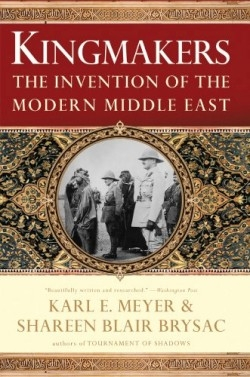Kingmakers
The Invention of the Modern Middle East
The Middle East is unstable, war-torn, and generally hostile to the West; religious and/or civil strife, fanaticism, and militias are ever more dangerous; America is a clumsy meddler—and soaring oil prices a worldwide threat. Just how did all this come to be?
This story resonates with excitement—a dozen or so architects of nation-building, religious zealots, and plain scoundrels, almost all British, high-handedly cut up and parceled out much of the decaying Ottoman Empire after Turkey allied itself with Germany in World War I. They wrought a monstrous coil. Meyer and Brysac have combined their formidable research skills and narrative art to deliver a first-class, always engrossing account of events. They begin by presenting some off-site trial runs, so to speak, that set the pattern for playing high-stakes Monopoly in the Middle East.
The invasion and rule of Egypt (1882-1954), ostensibly to straighten out a bankrupt administration and protect the Suez Canal; the Jameson Raid (1895), conspiratorially devised to aid the “oppressed” British incomers to Boer territory and shift control of the Transvaal from the Dutch to the British; the rule of Nigeria (1900) to protect British trade—all of these proved to be laboratories for perfecting the techniques of domination.
Meyer and Brysac don’t present a dry post-mortem merely recording how the corpse was dismembered but highlight a unique caste of driven Britons (the Americans were fewer and participated later) who took a gung-ho approach, “building nations, defining borders, and selecting or helping to select local rulers.” Most knew no hesitancy; they should “if necessary, unilaterally and proactively advance the Empire’s interests, since these coincided in any case with humankind’s,” as Colonial Secretary Joseph Chamberlain assured one and all. And what a cast of characters these kingmakers were.
If Lord Cromer, for long the eminence grise ensuring an Egypt pliant to Britain, was a model of heavy-jowled imperturbability, then Flora Shaw, supporter and later wife of Lugard of East Africa, was a live-wire, get-you-on-board journalist, with the Times (her employer) in her pocket. The charming aristocrat Mark Sykes was the fixer par excellence. In 1915 his Sykes—Picot agreement secured the greater part of Syria for Britain, leaving France with Lebanon; he then successfully pushed for the Balfour Declaration (1917), which virtually guaranteed the future Israel. Gertrude Bell, an Arabic speaker and expert on Iraq’s tribes, helped ensure that the Sharif of Mecca’s sons apprehensively mounted the thrones of newly gerrymandered Syria, Iraq, and Jordan, then to be deposed or murdered (they were hardly beloved locals)—only in Jordan do they still reign.
In Arabia in 1916 the brilliant outsider T. E. Lawrence created a new dimension in guerilla warfare in raising a revolt against the Turks. In 1933, after the handsome desert sheikh Ibn Saud won the throne, the treacherous insider St. John Philby ensured that America, not Britain, secured the oil concessions. In Persia, divided in 1907 into British and Russian spheres of influence, Britain found oil (essential for her navy) in 1909. Later Britain was to back Reza Khan as shah-by-seizure. In 1953 the British and Americans (Kermit Roosevelt i/c) engineered the ouster of the patriotic prime minister Mossadegh, bringing back Shah Reza Mohammed, who later lost his throne. In a return to Egypt we witness the ouster of the comic-operetta King Farouk and the ill-fated Anglo-French Suez Canal fiasco of 1956. The current travails of Israel and the sorry fate of Iraq round out events.
Meyer and Brysac do not stint on recounting America’s post-WWII role in policy guidance and regime change in Syria, Persia, and Iraq. Readers may well conclude that not having analyzed Britain’s many mistakes, the Americans brashly repeated them….
The authors’ greatest gift in their magisterial yet accessible narrative is their capacity to present context: in what framework did events happen? What were the motivations? They quote illuminatingly from primary sources: we learn what the principals said. A thoughtful epilogue summarizes pitfalls in policy-making; a map and chronology handily serve readers, while photographs illustrate the peerless paladins of yore. A most necessary and rewarding book, and a primer on what not to do in the Middle East.
Reviewed by
Peter Skinner
Disclosure: This article is not an endorsement, but a review. The publisher of this book provided free copies of the book to have their book reviewed by a professional reviewer. No fee was paid by the publisher for this review. Foreword Reviews only recommends books that we love. Foreword Magazine, Inc. is disclosing this in accordance with the Federal Trade Commission’s 16 CFR, Part 255.

